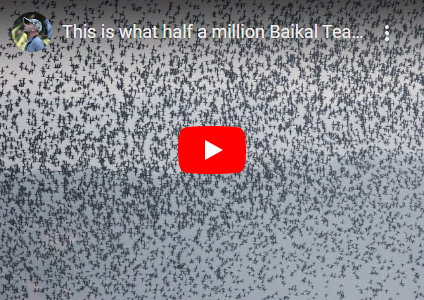South Korea Winter Birding Trip Report January 2023
Tour Leaders: Nick Upton, Nial Moores & Lee Collins
Dates: 3rd – 15th January 2023
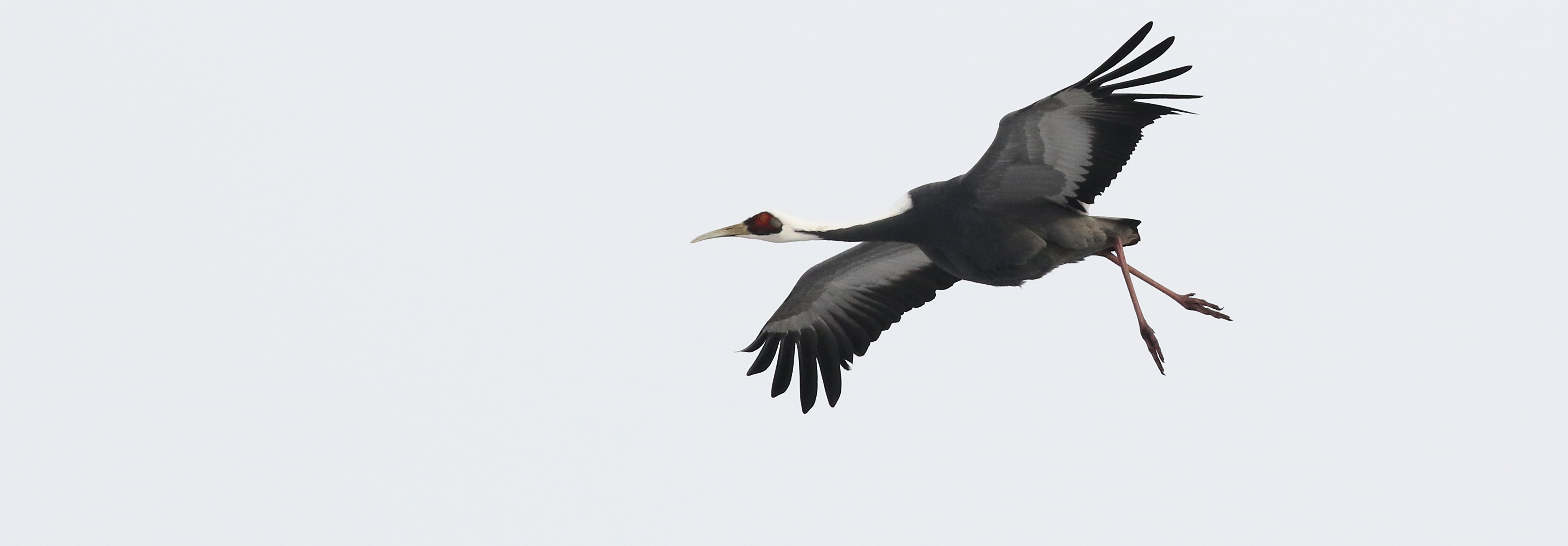
South Korea Winter Birding Highlights: The following list is of birds that gave us a real moment of excitement or a lasting memory because of their rarity, the sheer spectacle they created, the quality of the view we had, some interesting aspect of behaviour, because a member of the group had a personal connection with them or because of the sheer expectation of seeing them.
- Swan Goose
- Mandarin Duck
- Harlequin Duck
- Stejneger’s Scoter
- Smew
- Scaly-sided Merganser
- Eastern Water (Brown-cheeked) Rail
- Sandhill Crane
- White-naped Crane
- Red-crowned Crane
- Hooded Crane
- Long-billed Plover
- Solitary Snipe
- Saunders’s Gull
- Relict Gull
- Ancient Murrelet
- Rhinoceros Auklet
- Oriental Stork
- Cinereous Vulture
- Golden Eagle
- Hen Harrier
- White-tailed Eagle
- Steller’s Sea Eagle
- Upland Buzzard
- Eurasian Eagle Owl
- Japanese Pygmy Woodpecker
- White-backed Woodpecker
- Bull-headed Shrike
- Chinese Grey Shrike
- Azure-winged Magpie
- (Oriental) Rook
- Yellow-bellied Tit
- Varied Tit
- Chinese Penduline Tit
- Vinous-breasted Parrotbill
- Pale Thrush
- Naumann’s Thrush
- Dusky Thrush
- Red-flanked Bluetail
- Brown Dipper
- Japanese Wagtail
- Chinese Grosbeak
- Asian Rosy Finch
- Long-tailed Rosefinch
- Meadow Bunting
- Chestnut-eared Bunting
- Yellow-throated Bunting
- Pallas’s Reed Bunting
Summary
Just a quick look at the list of birding highlights for this South Korea winter birding tour and it is easy to see what an exciting destination for birding this overlooked country can be. Not only did we find a very high proportion of our target species, we enjoyed some real wonders of nature in some of the big flocks of birds we saw that included masses of cranes and huge numbers of wildfowl. Starting at Incheon we did some birding in nearby parkland and wetlands before starting the birding tour proper at the national arboretum where we enjoyed a variety of woodland birds plus a very special wader in Solitary Snipe. From here we moved towards the border with North Korea to enjoy watching spectacular numbers of Red-crowned and White-naped Cranes before moving back to the outskirts of Seoul and the Han River for Steller’s Sea Eagle. Although it would be hard to top this magnificent bird we moved down the west coast to Hwaseong Wetlands for a wide variety of wetland species and raptors before moving further south to Gunsan. From this city we visited the Geum River and coast for several key species but the highlight was a flock of half a million Baikal Teal. After a morning of thousands of Rooks we visited Suncheon Bay on the south coast to witness the incredible sights and sounds of an army of Hooded Cranes. On our way to the city of Busan we stopped at a secluded river for some Scaly-sided Mergansers before enjoying the next morning birding at Junam Reservoir which provided us with a very large day list and a few surprise birds. Our journey from Busan took us north along the east coast stopping at bays, headlands and harbours to watch a variety of alcids, gulls, sea ducks, grebes and divers before out last stop at Namhansanseong provided us with White-backed Woodpecker as out last new bird of our South Korea winter birding tour.
Join us on our next winter birding tour to South Korea. See the full itinerary and book here – South Korea Winter Birding Tour.
Field Guide
Birds of East Asia by Mark Brazil, published by Helm. In the absence of a quality field guide devoted to South Korea this publication is more than adequate and contains all the species seen on this birding tour. The checklist issued to clients was based on IOC taxonomy with reference to names used within this field guide.
Day 1; 3rd January – Arrival, Incheon
While this day was allocated for arrival only all members of the group had assembled at our hotel near Incheon airport by midday so we went for a birding walk in a park and large area of rough habitat overlooking a coastal area with mudflats at low tide, close to the hotel.
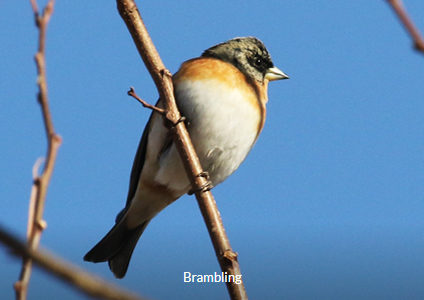
This unscheduled few hours of birding proved to be a very pleasant introduction to the birds of South Korea with super close views of a group of handsome Black-tailed Gulls on a slipway close to the hotel along with a small number of Common Gulls and a Vega Gull. On the water we could see a group of distant Common Mergansers (Goosander) but quickly moved into a small, nearby park where we were able to see some of the commonest species that we would repeatedly see throughout the tour; Brown-eared Bulbul, Eastern Great (Japanese) Tit, Oriental Magpie, Oriental Turtle Dove and the handsome Daurian Redstart.
Although it is a species fairly familiar to most of the group it was nice to find a flock of 30+ Brambling feeding on the ground before they flew up into the surrounding trees and we all appreciated our first Yellow-throated Buntings. This attractive bunting is a common species in South Korea but one with a lot of visual impact and character. There was obviously an abundance of food in this area for seed-eating birds with a large gang of Eurasian Tree Sparrows also present as well as a small group of four Oriental Greenfinches calling from the top of a nearby tree.
These were all nice birds to see on our first birding session in South Korea, but all species that we could expect to see along the way on multiple occasions, however, creeping around in the undergrowth was a bird that I thought we might not get another view of: Naumann’s Thrush. A nice, rosy-breasted adult was feeding on the ground but flew up into a tree to give everyone a good view and it was a further slice of luck that it was joined by two more birds. As it happened, this turned out to be a good winter for Naumann’s Thrush and we saw good numbers of them throughout the tour but it didn’t make the moment of seeing this first one any less sweet for those for whom it was a lifer.
Moving out of the park we entered a much larger area of open, reedy habitat with plenty of scattered trees which did not turn out to be as productive as it first appeared it should be. However, from here we spotted a few Great Cormorants out on the river and our first Red-breasted Merganser while an Eastern Buzzard perched in a nearby tree was nice. Perhaps the most entertaining species in this area was Vinous-breasted Parrotbill. This cute little bird travels around in garrulous gangs, in winter, which can often be large in size and a couple of flocks in the long grasses here were fun to watch. With the light beginning to fade we started to walk back towards our hotel but were distracted by the strange sight of small flocks of Tundra Bean Geese in flight with towering apartment blocks right behind them. A single Greater White-fronted Goose with them was a nice addition to the afternoon’s birding list before meeting Nial Moores and enjoying our first meal together as well as trying some of South Korea’s warming alcoholic accompaniments. Overall, this was a very pleasant start to our South Korea winter birding tour.
Day 2; 4th January – National Arboretum
Having run several previous winter birding tours to South Korea I have some locations which are my favourites, and the National Arboretum is one of those so it was a pleasure to be there once again and to be able to share some wonderful birds with a new group of birders alongside Nial, and his expertise, and a good friend in Lee. With a dusting of snow this location has something of the feel of a “winter wonderland” and an abundance of birds always makes this a fun place for birding.

Upon entry, as we crossed the stream, a group of Eastern Spotbilled Ducks were accompanied by a Grey Heron and a couple of Great Egrets while in the surrounding trees Brown-eared Bulbuls were squeaking all around us and Yellow-throated Buntings were feeding on the ground.
One of the features of this location are the flocks of tits that rove around in the winter so it did not take us long before finding a group of Eastern Great Tits accompanied by Marsh Tits, a couple of Coal Tits and, best of all, several Varied Tits. Varied Tit is a stunning little bird and always one of the highlights of the trip for me regardless of the fact that they are actually rather common and seen throughout the trip. Another of these enjoyable but fairly common specialities of the region is Japanese Pygmy Woodpecker and the buzzing call of this tiny woodpecker alerted us to its presence several times on our walk around the arboretum, allowing us to get lots of excellent views. Great Spotted Woodpecker was a much more familiar bird for most of us but it’s always fun to see familiar birds in unfamiliar places in my opinion. The third species of woodpecker we found here was Grey-headed Woodpecker, quietly feeding on the soft trunk of a tree, allowing us to watch it and eventually walk away without disturbing the bird.
These were all birds that provided us with some good birding, with Eurasian Nuthatch and Siskin also to add but the main reason for visiting the arboretum was to get satisfying views of a much more range-restricted species: Solitary Snipe.

This site has been reliable for many years but disturbance continues to get to be more of a problem so, as with any scarce or rare bird, we were not completely certain we would find one. Slowly checking the secluded areas of the stream using our ‘scopes we were methodical in our search but for quite a time we were kept into suspense until Nial spotted one further down the stream. Everyone was able to get a view of the bird, at some distance, but the pressure was off. However, we had not yet witnessed the main event and things went up a notch when a second Solitary Snipe fluttered out from under our feet and settled just a short distance away in the stream. We were treated to incredibly good views of this wonderfully marked bird as it foraged along the rushing stream; eventually we left it to its own business having been able to watch it for as long as we liked.
With this huge success we continued our walk enjoying views of more Siskins, Varied Tits, Japanese Pygmy Woodpeckers and a lovely flock of Bramblings that blended in with the leaf litter until they moved. A Goldcrest made us work quite hard to see it among the coniferous foliage while a Hawfinch and overhead Cinereous Vulture were the first of the trip. As the afternoon drew on the temperature in the shade really plummeted so we decided it was time to move on and make the drive to our accommodation, around an hour away. After settling in we headed to one of my favourite little restaurants of the tour where they serve some excellent local food and steaming hot meat dumplings. A little Soju may have been involved in dinner too as we discussed the best birds of the day and some of the conservation issues that affect them.
Day 3; 5th January – White Horse Hill, Cheorlwon CCZ, Gunnam Dam & Hamtam River
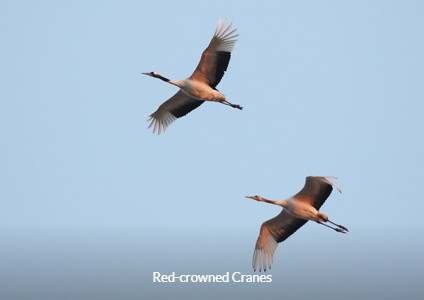
This morning is always much-anticipated on our South Korea winter birding tours with the hope of seeing a spectacular display of the flight of the cranes as they emerge from their roost site in some hot springs within the DMZ and fly out into rice fields and various wetland areas to feed. An early start got us to White Horse Hill at first light and we needed to be well wrapped up in multiple layers of clothing as we walked up the snow-covered steps to our observation point. A small group of both White-naped Cranes and Red-crowned Cranes were already sitting in a distant field, huddled up against the cold but it was the spectacle of them in flight that we were really awaiting. After slightly longer than was comfortable small groups of cranes began flying past in the distance. Small groups became slightly larger groups and the distance became less and less until some groups were coming right past us and settling in nearby fields, all accompanied by the magical cry of both species. A Hooded Crane flew close by too, giving everyone another new bird but there would be time to appreciate this bird in bigger numbers later in the tour.
When the flypast was over and the cranes settled we walked back down towards the car park, with Marsh Tit, Eurasian Nuthatch, Japanese Pygmy Woodpecker and Varied Tit along the way. Walking along a nearby stream and scrubby farmland gave us nice views of a flock of Long-tailed Tits and Hawfinch as well as our first Rustic Buntings of the trip. A couple of Naumann’s Thrushes confirmed that this would be a good year for this smart bird but we had an appointment to keep with some locals who would help us access the restricted area of the Citizen Controlled Zone, a sort of buffer region before the more well-known Demilitarized Zone.
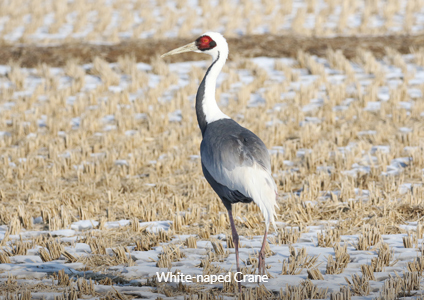
While the paperwork was being completed we were able to watch small flocks of Greater White-fronted Geese fly past before the soldiers waved us through. Driving along narrow farm tracks in the CCZ allowed us to enjoy the spectacular White-naped Cranes and Red-crowned Cranes in a different way, watching them feed in fields, often at close range, from the cars, although we were careful to avoid disturbing them. Overhead we spotted White-tailed Eagle and the monstrous Cinereous Vulture, although we would be able to gain even better views of these fantastic raptors further along our route. What we would not be able to improve on were the stunning views of Red-crowned Cranes, both on the ground and in flight as they moved from one feeding area to another.
As we approached a partially frozen creek we spotted a Bull-headed Shrike. Stopping here to get a good view of this handsome bird we took a walk along the creek where large numbers of buntings were present on the ground, in shrubs and on treetops. The majority of these were Rustic Buntings and Yellow-throated Buntings but with the sun coming out we were able to get great views of both. However, there were also good numbers of Meadow Buntings that got much of our attention. This beautiful little bunting has been hard to find on previous trips so we were very pleased to be able to get great views of good numbers of them and we would bump into them elsewhere along our route too.
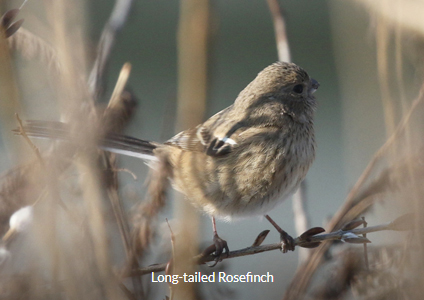
Oriental Greenfinches were another nice distraction but Nial detected the call of Long-tailed Rosefinch from the dense vegetation so the search for this cute little bird was on. In winter this species spends a lot of its time foraging within stringy undergrowth and this made it hard for us to locate. At a point at which we had more or less forgotten about it, to spend our time watching other birds, Troy called out that he could see a Long-tailed Rosefinch on top of the nearby bushes. Some of us spotted it quickly but it disappeared before everyone got a view of it so we descended to a trail alongside the area we had seen it in. Over the course of the next twenty minutes or so we had repeated views of at least two Long-tailed Rosefinches as they moved from one side of the water to the other and then back again. Good views of a nice bird and as much as we love those little brown jobs it was unfortunate that both birds were females, with no rosy plumage so this would be a bird we would continue to look for throughout the tour.
With this success it was time to move on and we continued our drive around the farm tracks through the CCZ, enjoying the groups of cranes and geese along the way. Greater White-fronted Geese were very abundant but also Tundra Bean Geese were obvious too. We scanned these flocks looking for Lesser White-fronted Goose, to no avail but it was still enjoyable to be able to see birds in large numbers. In reedy ditches alongside the farm tracks we found a few Pallas’s Reed Buntings and some more Meadow Buntings while raptors included Eastern Buzzard, Eurasian Sparrowhawk, Common Kestrel and Hen Harrier.
Our stomachs were indicating that lunch was more than overdue so after leaving the CCZ we drove a short distance to the Imjim River at Gunnam Dam where we found a good spot to eat our picnic lunch while looking out over the river. In the river a small group of Red-crowned Cranes were feeding and good numbers of Goosander, Eastern Spotbilled Duck and Mallard were on the water. A group of Cinereous Vultures gathering nearby was impressive as was an extremely well-marked juvenile Golden Eagle soaring above the dam. Golden Eagle is a very uncommon bird in South Korea so it was an exciting and unexpected species on this birding tour. Gunnam Dam is one of the few known breeding sites of Hill Pigeon in the area and our main reason for visiting the location. Scanning the dam we initially came up without any pigeons but then suddenly a small group of them came flying in, displaying their attractive tail banding pattern in the process. Although very similar to more familiar close relatives Hill Pigeon is a smart bird and one that I had managed to miss in a variety of locations in the past so it was a nice one to catch up with.
A walk along the river and overlooking some thick scrub turned up groups of Eastern Great Tits, Marsh Tit, gangs of chirruping Vinous-throated Parrotbills and lots of Oriental Turtle Doves. A Siberian Accentor was spotted but then disappeared. Everyone joined the search and several lucky members of the group refound it but it was rather secretive and sadly did not perform for all although Daurian Redstart, Yellow-throated Bunting and Rustic Bunting were more accommodating. Back over the dam many Cinereous Vultures were massing and a large Northern Goshawk was also spotted while a nice Bull-headed Shrike provided a photographic opportunity for those with a camera.
Another short drive took us to the outskirts of town, to a park on the banks of the Hamtam River where we were hoping to find a pair of scarce key species. The river is around one hundred metres wide but quite shallow, with rushing water over a stony riverbed with several small man-made weirs; a perfect place to look for Japanese Wagtail and Long-billed Plover. Local knowledge is invaluable on these trips and this was proven with the speed of which Nial found our first Long-billed Plover, parading around on one of the small weirs where he said they are usually to be found. On the far side of the river, in a small inlet we spotted a Mongolian Gull as well as a female Smew. Scanning the shallow edges we also found a few Buff-bellied Pipits and at least two Green Sandpipers before locating several more Long-billed Plovers a little further down the river. However, it was Japanese Wagtail that drew our attention when we eventually found one. Although we had tickable views this particular individual did not exactly give us the experience we were hoping for, luckily we had several other locations for this regional endemic later in the tour.
As the sun began to set we travelled the short distance to one of Nial’s favourite restaurants where we chose from pork BBQ or a local tofu preparation, both accompanied by a range of side dishes while several members of the group were introduced to the delight of makeoli, a Korean rice alcohol, before we returned to our hotel after a long and full day.
Day 4; 6th January – Han River at Paldang, Oido Tidal Flats & Hwaseong Wetlands
Considering our main target for the morning this was another highly-anticipated day of birding. Getting up early we drove for around an hour and a half to the Han River at Paldang. The Han River is the major river that runs through South Korea’s capital city, Seoul, and Paldang is one of the suburbs of this mega city. The river is wide and carved up with islets, rocky outcrops and gravel bars covered in vegetation and on arrival we could see a wide variety of waterfowl with Tufted Duck, Whooper Swan, Goldeneye, Smew, Goosander, Common Pochard to mention but a few. A couple of Carrion Crows loitered in the riverine scrub, a scarce bird here, while a few Olive-backed Pipits flushed from close by. Usually we can locate our main target, Steller’s Sea Eagle, loafing around on areas of ice, alongside White-tailed Eagles but on this occasion there was no ice and no eagle! Of course, it is normal that not everything goes according to plan on a birding trip so we had a plan “B” up our sleeve.
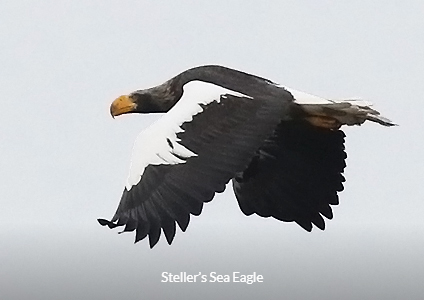
Driving several kilometres upstream, towards are large dam, Nial scanned the river from the moving vehicle. A crowd of Korean photographers alerted us to something worth looking at so finding somewhere to turn around we returned to see a magnificent adult Steller’s Sea Eagle perched upon a mid-river rock alongside two juvenile White-tailed Eagles. Parking quickly we ushered everyone across to the viewing point to enjoy this exceptional bird as it fed on prey that it had almost certainly stolen from one of the two White-tailed Eagles above which the Steller’s Sea Eagle towered. Taking in this impressive bird as it fed was exactly the sort of moment that had motivated most people in our group to travel to South Korea, so we enjoyed it until it took off and found a resting place in the pine trees on the valley slope.
Steller’s Sea Eagle would be more or less impossible to top but the river contained good numbers of sleek male Smew for us to enjoy. Scanning through the groups of Goosander downstream I spotted something special among them; a female Scaly-sided Merganser. Not quite the stunning male we were hoping for but nevertheless, we enjoyed watching this endangered species as it cruised along the river and began feeding in the rapids close to the rock we initially observed it sitting upon. The already familiar Daurian Redstart added a splash of colour close to the vehicles while a couple of Mongolian Gulls flew past with one brave individual harassing a White-tailed Eagle. With this double success and fewer birds on the river than we had expected we decided to drive to the coast, at Oido, where we hoped to find another globally rare bird in Relict Gull.
The journey took around an hour and a half and on arrival we could see that we had timed things well to see gulls pushed close to the harbour walls as the tide reduced the area of mud flats available to feeding birds. Good numbers of Black-tailed Gulls along with Vega Gulls made things look promising. Common Gulls were scattered around too but despite all of us scanning through them, the expected Relict Gull did not appear. A single Eurasian Oystercatcher and groups of Eurasian Curlews were a pleasant distraction but as the tide squeezed the exposed mud into a small triangle it was clear that our quest for Relict Gull, on this day, was a bird too far despite this being one of the most reliable sites for the bird in South Korea. Although this was disappointing we would have other chances at this rare gull so our first Heuglin’s Gull of the trip had to suffice as a consolation prize for now.
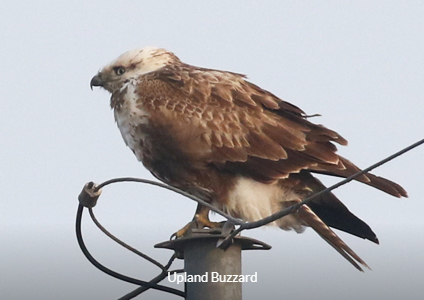
After something to eat we continued on our journey towards Hwaseong Wetlands. This large area of reed beds, rice fields, pools and reclamation lake has restricted access but our contacts gain us entry to this excellent birding spot where we hoped to find several key target species. It did not take long for us to find the first of these with a smart Upland Buzzard perched upon a roadside post allowing us to study it and for Nial to tutor us on the identification features. Its massive size alone was a big clue to its identity but in flight it revealed all of its key details. Lots of small birds flittering in and out of the reeds proved to be a mixture of Pallas’s Reed Bunting and Common Reed Bunting although both were tricky to get onto while groups of Vinous-throated Parrotbills confused the issue alongside them. Everyone managed at least a brief ‘scope view of Chinese Penduline Tit, although we put that one down as a work in progress, before Nial spotted another of our main targets here: Chinese Grey Shrike. Perched on top of a tree within the reeds it was easy for us to observe this stunning shrike warming itself up in some late afternoon sunshine. Eventually our attention was drawn away from the shrike by an impressive close fly past by an adult male Hen Harrier. In fact we saw several of these raptors hunting over the reeds as well as a couple of Rough-legged Buzzards and, of course, lots of Eastern Buzzards.
As the light began to fade Nial told us that if we were to drive the tracks we might get lucky with some mammals and that we could exit the wetlands at a point closer to our hotel. We did see Korean Water Deer, but nothing else, and our exit was slowed somewhat by an unexpected barrier across the track after dark. We found a novel solution for that obstacle and were able to enjoy a change of diet with some Indian food after checking into our comfortable hotel.
Day 5; 7th January – Hwaseong Wetlands & Guem River and Coast

This morning would give us much more time to explore Hwaseong Wetlands and with only a short drive to reach the location, we arrived just as the sun was rising. As we drove along the coast we could see large numbers of birds on the mudflats and with the light behind us we decided to make a stop at a fishing wharf to check out the flocks. The first thing I noticed were flocks of Dunlin foraging along the water’s edge as well as good numbers of Eurasian Curlews. A little scanning also revealed plenty of Eurasian Oystercatchers, looking handsome in the early morning light, a bird that is designed to put a smile on your face. Given our failure on the previous day with rare gulls the generous scattering of white birds on the mudflats became of prime interest to us. Many in the group were keen to get to grips with Vega Gull and Heuglin’s Gull so Nial was busy giving a masterclass on these alongside the accompanying Black-tailed Gulls and Common Gulls. While this was in progress I looked through some of the more distant birds and came up with something odd that looked like one of our most hoped for gulls. A quick look through my ‘scope and Nial confirmed what I had thought; Relict Gull. Gathering all of our telescopes in the least windy corner we frantically tried to locate the bird for everyone to see. With everyone eventually having satisfying views of this globally rare bird we decided to walk much closer to the birds by proceeding down the jetty which had previously been closed. Now the workers had opened the gate we were able to get much closer views of all the birds with some nice morning sunlight illuminating them. Tidal movement meant some movement of birds and it was soon after that our first Saunders’s Gull was spotted. This elegant little gull is rather reminiscent of a tern when in flight and using this we were able to pick out several more and were treated to at least three birds coming in close to us.
A double of rare gulls at an unexpected location was a real bonus and one of those events that puts everyone on a high for the rest of the morning. After adding a lone Grey Plover to our tally, a visit to the toilet gave us time to encounter Eurasian Hoopoe in the unlikely location of a windswept car park before moving into Hwaseong Wetlands proper. Things were considerably breezier than they had been on the previous day which always makes birding in reedy areas tricky. Instead of wasting our time staring into reeds thrashing around in the wind we drove slowly along looking for areas more protected from the elements. In this way we found a Grey-headed Woodpecker in a hedgerow as well as a couple of Meadow Buntings perched next to the vehicles. Further along we got out to check out a mixed group of Tundra and Taiga Bean Geese with a Cinereous Vulture resting close by; presumably it was digesting part of the dead Korean Water Deer that we found in the road.
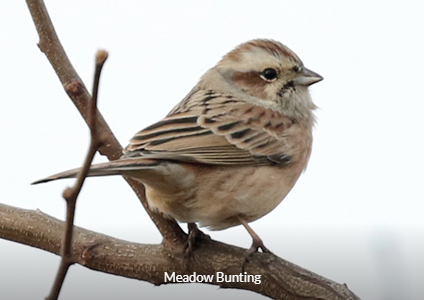
Another stop a little further along found us an area of reeds somewhat more protected from the wind and this proved to be a little bit of birding magic with excellent views of Chinese Penduline Tit and Pallas’s Reed Bunting obtained for everyone. A flyover from some Whooper Swans was nice as was a close fly past of a White-tailed Eagle. A scattering of Yellow-throated Buntings on the roadside also contained a few Black-faced Buntings which we were all able to get good views of with a little effort. Overlooking a creek lined with reeds produced a couple of great sightings of hen Harriers hunting and a real surprise in a Eurasian Bittern, always a special bird to see. On the subject of special birds, Nial informed us that close by were a few pools where he had high hopes of finding Oriental Stork. Crawling along in the vehicles the first pool turned up a blank so expectations were very high for the next one. It seemed like we would be out of luck when we could see into the second pool until suddenly Sharon exclaimed, “there it is!” The “it” in question was a single Oriental Stork tucked into an overgrown corner of the pool and with a fortunately located gap in the reeds we were all able to view this magnificent bird. Eventually it took flight to reveal its “piano keys” flight feather plumage as a finale to its performance.
From here we took a walk in the ever-improving weather with the wind abating in the sun struggling through. In the next pool we discovered a group of Eurasian Spoonbills and a couple of Little Egrets while in the creek there was a mass of wildfowl. This flock included large numbers of eastern Spotbilled Duck and Mallard as well as Eurasian Teal, a few Smew and Goosander as well as good numbers of Great Cormorant. Overhead several (Far Eastern) Skylarks passed by, uttering their distinctive call and these were followed by a single Lapland Longspur. With lunchtime approaching and all of our target species for the area seen well Nial suggested that we use the early afternoon to make the drive towards our next location where we would stay for two nights; Guem River and Coast close to the town of Gunsan, where he hoped to finish the day with something very special.
We arrived close to the Guem River and took a quick scan over the water. Large numbers of common wildfowl were present as well as a flock of Black-headed Gulls but our main target was nowhere to be seen. Moving further along the river we stopped to check through a group of close and perfectly lit Taiga Bean Geese and Greater White-fronted Geese accompanied by Whooper Swans.
With the late afternoon glow on our backs we ascended the river flood defences and there in front of us was what we were looking for; THE flock of Baikal Teal. Nial is an expert in counting flocks of birds and by his estimate there were 500, 000 Baikal Teal in one single flock, most of the world population. While on the water this conglomeration of birds looked something like an oil slick at a distance but through the telescope we could see the distinctive pattern of colours of the male birds. In fact, fortunately, a few individuals had decided to lurk in the shallows quite close to us so that we were able to enjoy both the spectacle of the mass of birds as well as the detailed beauty of a few individuals. However, as the sun began to set the real show began with the Baikal Teal taking off en masse and forming a sort of rolling flock, moving along the river before taking off as one of flying along like a whisp of smoke. When the whole flock was airborne at the same time it was so dense that anything behind them was blocked from view. Watching this wonder of nature is unforgettable and something we are always happy to share with a new group of birders.
As the flock of Baikal Teal drifted off into the sunset the temperature plummeted so we jumped back into the vehicles to head to our hotel in Gunsan, enjoying the sighting of a Short-eared Owl perched on a telegraph post along the way. From our hotel it was just a short walk into a nearby warm restaurant run by a very accommodating lady who supplied us with lavish servings of soju, makeoli, beer and fried eggs as well as delicious, piping hot meals.
Day 6; 8th January – Osik Park, Guem River & Coast
Today we had the luxury of our first birding stop being just a ten minute drive from our hotel. Osik park is a suburban woodland park set on a small hill and a location that provided a nice morning of birding with a very different set of birds to the previous few days. An icy slope meant that we had to be careful entering the park but once inside things were easier.
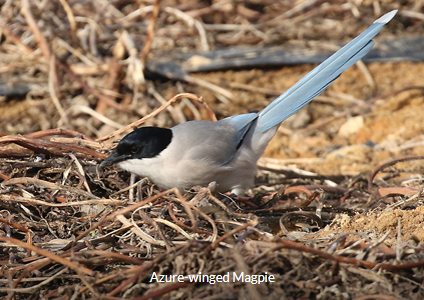
Our first “trip tick” of the day was a smart Eurasian Jay put in an appearance followed by a small group of Azure-winged Magpies flitting around between low bushes. Apart from these birds things were a little quiet but overhead several Great Cormorants and Mongolian Gulls flew by while on the ground we flushed a small party of Olive-backed Pipits. Slowly moving up the slope we listened carefully for any bird sound we could detect with a party of Yellow-throated Buntings and Rustic Buntings foraging in the undergrowth giving themselves away with low contact calls. A pair of Korean Water Deer on a snowy bank made a nice interlude and while we were enjoying this Nial picked up one of the most scarce woodland birds that we see on this South Korea winter birding tour: Pale Thrush. Turdus thrushes always have appeal to northern hemisphere birders so this example, perched on a low branch, performing for prolonged ‘scope views, was enjoyed by everyone.
A couple of Great Spotted Woodpeckers eventually drew our attention away from the Pale Thrush for a moment and when we looked through the telescopes again it had vanished. However, a little further up the slope we could hear the chatter of a flock of small birds feeding in a group. This revealed our first Warbling White-eyes and, to much pleasure, several Yellow-bellied Tits. Until fairly recently this colourful little bird was considered an East China endemic but over recent years larger and larger numbers of them have been wintering in South Korea and Nial suspects that breeding may occur soon if it has not done so already. Japanese Pygmy Woodpecker joined the party as did Eastern Great Tit, Varied Tit and Coal Tit before Nial heard the low call of Common Rosefinch. We couldn’t immediately find this bird but several minutes later Lee had it in his ‘scope for all to enjoy. This is a rare wintering species in South Korea and gave us that feeling of satisfaction that surprise birds always provide. By this time Vinous-throated Parrotbill and Brown-eared Bulbul had become familiar companions but a few Naumann’s Thrushes were still turning our heads. When this activity had died down we continued for some distance along the trail to look for Red-flanked Bluetail, a scarce but annual winter visitor in small numbers and at a sunny lookout we eventually heard one. After much searching one suddenly burst out of the thick undergrowth and gave the type of prolonged display that we could only have fantasized about. With this success and having reached the end of the trail we turned around and went back to the vehicles. While having a mid-morning snack from the vehicles and large gang of Azure-winged Magpies descended and gave us an impressive performance.
A short drive just around the corner for a coffee stop revealed another huge group of Azure-winged Magpies parading all over buildings, gardens and overhead wires and when we began to leave Troy spotted a big flock of Chinese Grosbeaks on roadside wires near another parkland area. This resulted in another stop, less than a hundred metres away from our original site but one that was very worthwhile with at least eighty of these beautiful birds feeding on fallen seeds and flitting from tree to tree. Having enjoyed these birds for some time we attempted to get back in the vehicles, only to be side tracked by yet another nice bird: Red-billed Starling. A group of eight were perched on a roadside wire and turned out to be the only ones we saw throughout the whole trip. We had other target species to look for in different habitats so having enjoyed a very good morning of birding we made our way to a creek to the north of Gunsan city close to rice stubble fields where we hoped to see a range of wetland birds.
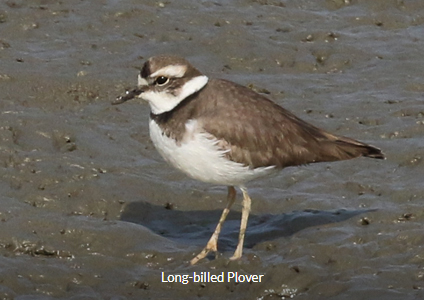
On arrival at the muddy creek the first bird we saw was Common Greenshank, as expected. Somehow, every time I go to this site Common Greenshank is the first bird I see but it was Long-billed Plover that was really the star of this visit. A few of these birds were present and one came fairly close to us with lovely illuminating light so that we could fully appreciate it. This was also where we saw out first Northern Lapwings of the tour as well as Eurasian Wigeon. Large groups of the commoner ducks were present too, such as Northern Pintail, Gadwall, Eastern Spotbilled Duck and Eurasian Teal. The tide was out a rather long way and the birds on the water’s edge were mere dots even if they were in impressive numbers so we moved on to another spot where we had noticed large numbers of geese feeding in stubble fields. By now we were used to seeing large numbers of Tundra and Taiga Bean Geese alongside Greater White-fronted Geese but here we came across really huge numbers of them. Most of the time they were with their heads down, feeding but every now and again their heads would go up to look for danger even though, to us, there did not seem to be any new threat or disturbance, hidden, as we were, behind the vehicles at an appropriate distance. Perhaps they had detected a passing raptor that we had not? Do geese see God? I will let the palindromists among you work out which. Overhead a wing-tagged Cinereous Vulture glided by and a very strikingly-marked Northern Goshawk raced past but it was the discovery towards the far side of the field that caused most excitement. A group of four Swan Geese were feeding alongside the commoner species and everyone was keen to take a long look at these scarce birds. Swan Goose is a species that we have found on every winter birding tour to South Korea but one that is always a challenge and seen only in small numbers at one or two sites so these ones were a very pleasing find.
With the day having been a very successful and full one already, we decided to head back to the Geum River to try and relocate the massive flock of Baikal Teal. Although we had already seen this impressive wonder everyone agreed that the spectacle of half a million birds was something worth taking a second look at, so once again we found ourselves on the river bank marvelling in the rolling movement of hundreds of thousands of Baikal Teal as the sun began to set behind them. We did not leave until it was almost dark and were looking forward to our warm restaurant, good food, a sip of alcohol and lengthy chat about the day’s birds but as we got to our favourite restaurant we were told it was closed, in complete contrast to the fact that there were other customers there! Apparently according to Mr, there was no rice available for our Bibimbap so we had to leave. Nial had a bit of a word and Mrs said there was enough rice for three people. Well, the others could eat noodles surely? Mr said no but Mrs over-ruled him and suddenly there was enough rice for everyone and another pleasant meal and discussion ensued. Just one of the things to keep us on our toes in South Korea.
Day 7; 9th January – Mangyeun Reservoir, Suncheon Bay & Merganser Creek
Some species on our South Korea winter birding tour are globally rare, some have restricted ranges and these fuel the desire to travel and see new birds. However, as demonstrated by the Baikal Teal, many of the birds we see are impressive because of their sheer numbers and this morning’s first birding stop was hopefully going to present to our group a bird that most of them were familiar with but in such numbers that they had not seen before. The species in question was (Oriental) Rook. A short drive got us to a small reservoir at Mangyeun just as the sun was rising. On the lake itself we were able to good numbers of the more common ducks as well as spotting a few Falcated Ducks. We got acceptable views but the light was not really in our favour so this would be one of those birds to look for again and we would have a good chance at Junam on the following day.

Small groups of Tundra Bean Geese flew past as well as Greater White-fronted Geese but the first group of Rooks were spotted in the distance, a rolling group of around five thousand birds moving around over the tree line on the far side of the lake. As we watched them they came closer and closer forming up with another large flock to become a mass of birds. Once overhead we scanned through this impressive Rook flock and found what we were looking for; an adult Daurian Jackdaw. A few of these pied corvids always join these massive winter flocks of Rooks it is just a question of finding the roving groups and scanning through them. No mean feat when there can be up to fifty thousand birds in one group. Over the course of the next half an hour a few more flocks of several thousand Rooks came by, all heading in the same direction and all containing one or two Daurian Jackdaws. While this was happening, on the other side of the lake there was a huge movement of Great Cormorants. We had already noted several thousand of them sitting in the trees around the lake but the movement of them was quite spectacular, with probably as many as fifteen thousand birds heading out to the nearby sea.
This impressiveness of this massive movement of Cormorants and Rooks was not lost on those in our group but a handsome Dusky Thrush perched on a nearby bush was a different type of distraction. Illuminated in the morning sunshine this was an exceptionally attractive bird and, unusually, the only one we would see on the trip. On other occasions we have seen many Dusky Thrushes but the weather conditions this year meant that they were thin on the ground. Although we were able to identify Daurian Jackdaws in flight we hoped to see them at closer quarters so we took a little drive in the direction in which we had seen them flying. It didn’t take long before we found them, thousands of birds feeding in fields and perched on roadside wires, with several adult Daurian Jackdaws showing well as well as a couple of, all black, younger birds.
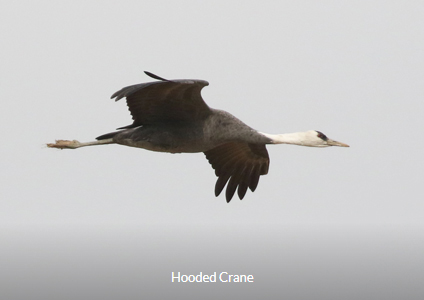
With this entertaining start to the morning coming to its natural conclusion we decided to make our way to Suncheon Bay with the promise of big numbers of Hooded Cranes to continue the theme of big numbers of birds. A couple of hours later we were rolling into the stubble fields at Suncheon and right in the middle of the action with cranes to left of us, cranes to right of us, cranes in front of us, whooping and thundering! Thankfully it was not the valley of death into which we drove but we did find ourselves in a superb location right within the area besieged with impressive numbers of birds. The most obvious species, and the one which we had come to see, was Hooded Crane, with several thousand of these attractive birds feeding in fields all around us as well as flying to and fro overhead. At all times the magical calls of the cranes could be heard as they kept in contact. As birds flew by calling we noticed that they would open their bills before blasting out their sound as their bills closed, an interesting technique that more musical people than I may be able to explain. As well as the cranes there were large numbers of wildfowl flying in and out of the area while the massive Cinereous Vultures loomed overhead, at times coming so low and close it felt like they were going to attempt to feed on members of the group.
Fortunately the vultures detected life in all bodies and left us alone allowing us to take a walk alongside reedy ditches where we found Pallas’s Reed Buntings, the ubiquitous Daurian Redstart, Rustic and Yellow-throated Buntings. From the densest part of a clump of reeds the call of a Dusky Warbler alerted us to its presence and although the chances of seeing this little skulker did not seem good it did eventually show itself to everyone.
After a short break for some lunch we drove a very short distance to another area of rice stubble where we had spotted another flock of Hooded Cranes and an assortment of geese. Once again we searched through the flocks of geese looking for the elusive Lesser White-fronted Goose and once again without any luck. However, we had more luck while inspecting the Hooded Crane flock consequently discovering a Common Crane tucked in among the multitude. Once again, by standing in this spot we found ourselves surrounded by an impressive number of birds; cranes, geese and ducks. The sights and sounds of this mass of birds was quite magical and we could have imagined being transported back in time had it not been for the strange backdrop of apartment blocks and a busy road. Having enjoyed the flocks of Hooded Cranes to their full we had one more stop to make for a couple of other top quality birds. This would take a moderate detour from our drive to Busan so we ensured we had time to fit it in by leaving mid-afternoon.

By the time we reached our destination it was late afternoon and the shadows were beginning to fall in the gorge that contained the rushing river here. Our first stop provided the success we were hoping for in two pairs of superb Scaly-sided Mergansers at close range. Although we had “ticked off” this species earlier in the trip it had been a female that we had seen and at not an especially close a distance. The proximity at which we were able to watch these birds meant that we could clearly see the scaly sides that give this bird its name, a feature that can often be tricky to see in bright light or at long range. With another key species to find we took a very short drive to another stretch of the river where the last of the afternoon sunshine was illuminating the scene. Several more Scaly-sided Mergansers were loafing around on sunlit rocks in mid-stream while Common Sandpipers hurtled up and down uttering their high-pitched call. Improved views of Japanese Wagtail were a nice bonus here with a couple of birds foraging along the water’s edge but the main event here was Mandarin Duck. Many of the group had seen plenty of feral Mandarin Ducks in Britain but for most these were the first “real” ones and they looked stunning in the soft, late afternoon light. As we were celebrating the successes of the day’s birding and preparing to leave, the deep call of a Eurasian Eagle Owl caused a halt in proceedings. We could all tell that the sound was emanating from a cliff on the opposite bank of the river so all eyes were scanning. After ten minutes or so most of us spotted our target as it flew a short distance and landed on an exposed rock. As the light was failing it was not easy to spot but with three telescopes trained upon it everyone was able to get good views of Eurasian Eagle Owl as it sat calling from its rocky pinnacle. All that was left was to make the drive to Busan, stopping along the way for some dinner, before checking into our comfortable hotel where we would stay for the next two nights.
Day 8; 10th January – Junam Reservoir & Nakdong Woodland Park
Some birding sites are visited for specific target species but Junam is an area that offers a wide range of species and large numbers of birds all at the same time as well as being a back-up site for a number of scarce species. This is one of my personal favourite spots and by spending most of the day here we would give ourselves the best chance of finding a great variety of wetland, farmland and woodland birds and have the time to maybe turn up something less expected. More than anything else Junam is just a nice place to spend time and see a high total of species in a single day.
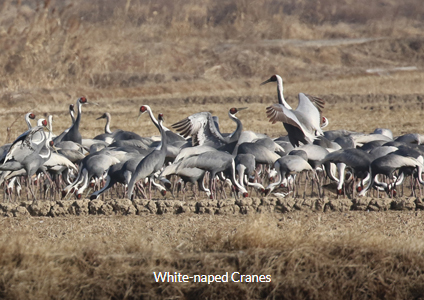
Things did not look to promising when we first arrived with the main viewing points being closed off due to bird flu prevention measures; hmmm. However, just around the corner from this challenge we found a big flock of White-naped Cranes with a very convenient place for us to stop and admire them. Once again standing, watching and listening to the cranes was a magical experience and as we inspected them closer we could see that there were some Hooded Cranes among the flock. Even closer inspection revealed four Sandhill Cranes feeding amongst the crowd, presumably members of the little-known Siberian population of this species. For the US contingent of our group it was fun to see a familiar bird in an unfamiliar place. For the rest of us it was great to see an impressive bird that we do not get to see very often if at all. A Common Crane was another nice find to make it four species of cranes in one group; very cool.
Behind us, in the scrubby vegetation, groups of chattering Vinous-throated Parrotbills passed through in their quest for food while a few Oriental Greenfinches perched on the tops of small trees. A variety of geese and commoner ducks were ever present in the stubble fields but smaller birds flittering around close by drew our attention. Small flocks of Buff-bellied Pipits were easily found when looking more closely and among them were small numbers of (Far Eastern) Skylarks, a bird we had not had a good view of until now. More larks continued to arrive in close-by fields, not quite an exaltation but good number nevertheless. We were able to study them in good light while Nial explained the differences in these birds compared to the Eurasian Skylarks we were more familiar with and why these might be split at a later date. While my ears, as well as Nial’s, were uncharacteristically switched off for a moment Stephen alerted us to a call that he thought sounded different to the common buntings we had been seeing. He was right! Sitting on some reeds in a nearby ditch was a nice Chestnut-eared Bunting, one of the most-wanted and scarcest buntings we had a chance of seeing at this location. A second bird revealed itself a little further down the reedy ditch before a third individual arrived: superb.
Having enjoyed the birds here and the vista to its full we decided to head towards a secluded part of the lake where we felt sure there would be no “bird flu restrictions” but we were sidetracked multiple times by yet more interesting birds. First up was a surprise Long-tailed Shrike sitting beside one of the farm tracks which allowed us to stop, get out and take some photographs and while we were doing this a pair of Swan Geese flew right overhead, their distinctive call alerting us to the fact that they were incoming. Also in the area were a few White Wagtails as well as a small flock of White-cheeked Starlings to add to the rapidly-growing day list. After another brief stop for Mongolian Gull and Smew we found our way into the area we wanted to visit; next to the lakeside margins with reeds, emergent trees and small fields and orchards adjacent to the lake.
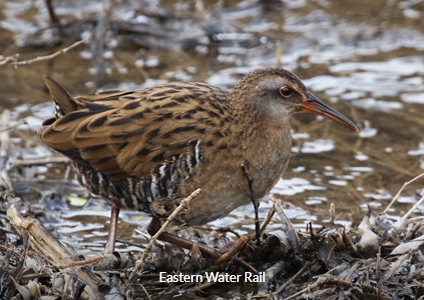
This area is always good for a wide variety of birds and we quickly found Marsh Tit, Buff-bellied Pipit, Yellow-throated Bunting and many other common birds but Alison had found something special; an Eastern Water Rail strutting around, like Mick Jagger performing “Honky Tonk Woman”, feeding on a pile of old persimmon. It scuttered off into the undergrowth before everyone had seen it but a little quiet waiting and back it was sneaking to peck perfunctorily at its putrid persimmon pile to give us another unexpected but very welcome bird. In the rank undergrowth nearby a Eurasian Wren made its ticking call before showing itself in the emerging sunlight for a few moments. In fact the emerging sun was quite notable, delivering the highest temperatures we experienced on the trip and resulted in layers of clothing being removed until at least one of us got carried away and stripped down to just a t-shirt! This was a nice place for our picnic lunch during which Troy found a second Eastern Water Rail.
A walk to the lakeside turned up a couple of Little Buntings before a few more Naumann’s Thrushes. Eurasian Spoonbills and Whooper Swans were feeding in the shallows while Light-vented Bulbuls were raiding fruits in a nearby orchard where another Wren popped up out of the grasses. A scan across the lake revealed a pleasant view of geese, ducks, spoonbills, cranes all feeding in the lake with a couple of White-tailed Eagles perched on branches protruding out of the water. A quick drive to another lake turned up what we were looking for; Falcated Duck in good light. At least eight of these lovely ducks presented themselves to us and it was nice to be able to get improved views having seen them in poor light before. Having had an excellent morning and early afternoon Nial suggested that we head back to Busan and try our luck overlooking the estuary and visiting a woodland park on a rocky peninsula.
The drive did not take too long timing it, as we had, before rush hour. A quick look from the promenade overlooking the estuary revealed large numbers of wildfowl in the distance with Black-necked Grebes and Red-breasted Merganser in close. A few Black Kites glided by overhead, this being the sliver of the country where this raptor is common in winter. This is usually a location to look for Relict Gull but as it seemed unlikely that we would improve on the views that we had already had we decided to head to the woodland park for a different target bird. A Ryukyu Minivet had recently been seen at this location so we went on a late afternoon search for this bird. Warbling White-eyes were easily seen, bundling around in a low bush, and a nice Japanese Pygmy Woodpecker gave a nice performance right next to the trail. However, as we made our way through the woods the only sounds we were hearing were of Brown-cheeked Bulbuls with a notable lack of flocks of small birds. At a viewpoint we were able to look out to sea where we were able to identify at least twelve Temminck’s Cormorants, a rather esoteric bird. A female Blue Rockthrush was another nice distraction but overall things were fairly quiet so we decided to call it quits and head back to our hotel for a warm shower before walking around the corner to eat a piping hot meal, and reconvene the soju appreciation society, to end a great day of birding.
Day 9; 11th January – Guryongpo Peninsula
Today would provide us with a real change of pace as we drove, at first light, towards the east coast of South Korea for the first time in this trip. In contrast to the mudflats of the west coast, the east coast consists of rocky headlands, long sandy beaches and lots of fishing ports of various sizes. With this different set of habitats comes a different set of birds, many of which were highly-anticipated. An hour and a half after leaving Busan we reached our first stop of the day, a long sweeping sandy beach looking out into a wide bay. In front of us huge numbers of Great Cormorants were swarming, chasing after fish that were being blown close to the shore by the wind. Good numbers of gulls were present giving us a chance to pore through them and test our skills. Snowy white Glaucous Gulls did not prove much of an id challenge but who cares when a gull looks as smart as this? Slavonian Grebes fishing off of some rocks were nice but although there were a lot of birds to look at there were none of the key species that we were hoping for so it was time to move along to the next stop.
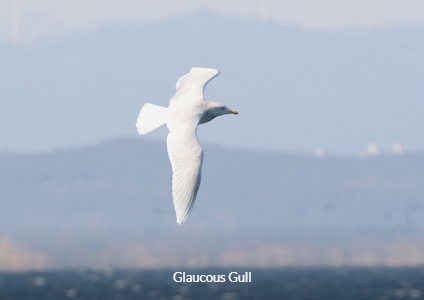
Over the course of the morning we made a series of stops as we headed east along the peninsula. At one breezy outlook we found a group of Sanderling on some rocks but Stejneger’s Scoter out to sea was something to savour, although it took a while for us all to get satisfying views. Harlequin Ducks frolicked in the waves between rocks while getting a good look at an Ancient Murrelet was a challenge because of the distance but there were very large numbers of them on the move. Taking some time to poke around a fishing harbour finally gave us the close views of this cute little alcid that we were looking for, although more dead ones than live ones floating around somewhat soured the experience. Sea watching turned up some Rhinoceros Auklets but these were rather too far away to really savour but at more or less every stop Light-vented Bulbuls would appear in bushes nearby so that we became familiar with this bird and its call.
Because the light was coming from behind us we were able to get good views of birds such as Red-throated Diver, Red-breasted Mergansers while staring out to the distant seas there were enormous numbers of birds on the move. Although the numbers of birds were extremely impressive, they were too far away to really enjoy or for anyone to identify most species without a telescope (even with the ‘scope it was hard) so a change of scenery was planned for. A drive of forty-five minutes or so took us north of the city of Pohang, through some attractive farmland scenery to another secluded coastal village which is known as one of South Korea’s few reliable locations for Russet Sparrow. Stopping at the village fuel station excitement broke out as we spotted a big flock of sparrows only for them to turn out to be Eurasian Tree Sparrows. Further into the village, more sparrows. Tree Sparrows once again! This set a bit of a pattern and as Nial set up for some more sea watching I took a walk up a small hill in the farmland in a search for sparrows. I immediately noticed some distant sparrows on a power cable some distance away which immediately proved to be Russet Sparrows after a quick look through the ‘scope. Now I had the task of rounding up the troops and getting everyone close enough to get a decent view of these attractive little sparrows. Somehow we managed to do this without much of a problem, a total of around twenty Russet Sparrows did fly a short distance away but we were all able to admire them as they joined some of the many Tree Sparrows in the area. With the light beginning to fail, the temperature starting to plummet it seemed like a nice way to end the day’s birding, on a success. Just over an hour later we were checking into another very comfortable hotel and then enjoying a great dinner in a restaurant run by two very nice ladies who went out of their way to accommodate us.
Day 10; 12th January – Tabaeksan, Ogke Services & Gangneung Lake
We were on the road at first light again, heading towards the mountain of Tabaeksan. It was a fair drive but along the way our route took us through pleasant countryside alongside a nice, icy stream where we hoped to find Brown Dipper. A couple of very cold and fruitless stops didn’t bode well for success but somehow Nial spotted one as we were driving along. Speeding traffic made it rather unsafe to view from where we were but luckily someone had created a lay-by for us a little further along, seemingly in anticipation of potential visiting Dipper-watchers. Stopping here allowed us to watch a pair of Brown Dippers as they foraged in icy waters and we marvelled at how well they are adapted to such conditions. I didn’t feel like I would last a minute in such frigid water and was glad of my warm shower before departure.

With this enjoyable stop concluded we continued the journey to Tabaeksan where we were pleased to see little snow on the access road, making our ascent an easy one. Whenever we arrive at Tabaeksan a search begins for the regular wintering flock of Asian Rosy Finches and with the large area of uniform barren fields to search through and very few other birds it can be a tricky and lengthy one. Very shortly after we arrived we spotted a small flock of finch-like birds feeding on the edge of a field very close to us but unfortunately these turned out to be Oriental Greenfinches. These posed very nicely for us though and made for very good photographing subjects in the clear light. On previous visits we have driven around the tracks that access the wind farm here and which run through a series of old cabbage fields until finding the flock of Asian Rosy Finches, often a seemingly hopeless task until they suddenly appear in front of us, so the fact that our first circuit of the area proved fruitless did not worry us too much. However, as time ticked by and we scanned from a prominent spot we did begin to become impatient. A few soaring Cinereous Vultures and a Large-billed Crow were only momentary distractions for the absence of Rosy Finches so a plan was formed; we would spread out along the road and scan from various positions and raise a hand if we found the flock we were searching for. The vigil began.
Eventually, as I was looking through my binoculars at everyone else, to see if they had a raised hand, I spotted a flock of undulating finches somewhere in the distance behind Alison. After a lengthy flight the flock descended to perch on a large piece of windfarm equipment but I could also see that nobody else was in the line of sight of these birds. Soon after the flock took to the air again, wheeled around and disappeared behind a ridge. A message from Nial on my phone indicated that he was on the ridge and had seen the birds so I got the group together and up onto the ridge we all hiked. We had not been up there before a group of around eighty or more Asian Rosy Finches raced over ridge and wheeled around, repeatedly close to us allowing us to get lengthy flight views of them in their lark-like flight. Of course, we all wanted to admire these birds on the ground but as they flew away into the distance it did not seem likely that we could re-find them without a very lengthy search so the decision was collectively made to move on to our next stop, which was some distance away and the location where we could find something to eat.
The drive was a scenic one, descending through the mountains and out onto the coast, eventually taking us to a rather unlikely birding spot; Ogke Services beside the highway but also providing a very nice overlook of the sea where there were good numbers of birds. It did not take Nial too long to spot one of our main targets, Long-billed Murrelet but it took a lot longer before we were able to get everyone a view of it through the ‘scopes at a “tickable” distance. Sea-watching can be an acquired taste and although the light was excellent, coming from behind us, a telescope was an absolute necessity here. Using them we could see large numbers of Ancient Murrelets moving south in the mid and far distance while nearer to the coast Goosander, Red-breasted Merganser, Harlequin Duck, Great Crested Grebe and Black-necked Grebe could be seen. Great rafts of gulls were also present but at this distance it was not possible for us to reliably pick out any rarities. Since everyone had seen the Long-billed Murrelet and we could not re-find them it was time to move on, this time to the lake and city park at Gangneung.

In previous years the lake at Gangneung has been partially covered in ice, with birds concentrated into the ice-free areas but the weather was uncharacteristically warm on this occasion and there was no ice at all. However, there were still large numbers of ducks and gulls on the lake, many of them very close to the walkways through the park giving us superb views in the late afternoon sun of Northern Pintail, Smew, Goldeneye, Goosander and a group of Greater Scaup, our first of the trip. All of these were familiar birds to everyone in the group but what was most certainly unfamiliar was being able to enjoy seeing many of these birds at such close proximity. Gulls loafing around on the rocks in the middle of the lake included a couple of nice first year Mongolian Gulls (there always seem to be a few here) and a couple of Slavonian/Horned Grebes provided a moment of name confusion among both the US and UK contingents of our group.
Gangneung lake in the late afternoon turned out to be a great spot for sunset photos and David used his charm to help us meet some friendly locals. However, in the end we departed for the coastal fishing town of Daejin where we would be based for the next two nights, stopping for dinner along the way in Sokcho. We concluded our day’s journey, after dark, at January Pension, a pleasant guesthouse where we made ourselves comfortable for the next two nights.
Day 11; 13th January – Daejin Coast
Today was the day that the weather turned. While we had experienced a variety of temperatures (most of them cold or colder) things had almost entirely been bright and dry. However, today provided a lot of rain in the form of a light to moderate drizzle, for much of the day. This put the planned boat trip to look for seabirds into question but January Pension is perfectly placed for such days and we were able to look out into the bay from the sheltered deck in front of the guesthouse and the balconies in our rooms. From here we were able to see incredible numbers of birds as well as add a number of species to our trip list. Firstly, even a brief glance revealed masses of Great Crested Grebes in the bay. Ok, for any birder from Europe this is a very familiar bird but had any of us ever seen almost six thousand of them all together in one mass, bobbing around on the waves? No, certainly not. Good numbers of Red-necked Grebe were spread thinly throughout the sea with little groups of both Black-necked and Slavonian Grebes present too. Immediately in front of us we could pick out small parties of gaudy Harlequin Ducks, Pelagic Cormorants skimming across the sea and landing in the water in large numbers and Rhinoceros Auklets moving through in the distance in large numbers. Many of the birds were a fair distance away but by spending time we were able to see all of the birds at closer range, including several parties of jaunty Rhinoceros Auklets. There were also plenty of Red-throated Divers as well as Black-throated and Pacific Divers.

The sea was quite a maelstrom of birds with the addition of groups of Red-breasted Mergansers piling in to the bay, with a couple of thousand birds building up over the course of the morning. Groups of Goldeye, Goosander and Eastern Spotbilled Duck made up the numbers and, of course, there were lots of gulls to struggle with; Vega Gull, Black-tailed Gull, Slaty-backed Gull, Glaucous Gull and Common Gull. However, there were a few sea ducks that we were hoping for that we had yet to see so we continued to watch and scan through the large numbers of birds in front of us. The first of the two species we were looking for made it easy for us, flying in and landing close to the guesthouse; a pair of Black Scoter. We were able to enjoy these two birds as they dived close to the rocks, looking for food but not all eyes were on these; Nial had continued to scan and had found a Stejneger’s Scoter on the edge of the Red-breasted Merganser flock. This was one of the more anticipated birds of the coast so everyone was keen to watch it as it drifted across the bay.
Stejneger’s Scoter was a great bird to more or less wrap up the sea watching session but the drizzle continued making most people reluctant to go out and get wet before the potential boat trip later in the day. A few of us walked along the seafront to the harbour while others continued to sea watch or catch up with emails in the comfort of their rooms. For those of us who braved the rain a handsome Blue Rockthrush was a reward as were a group of Pelagic Cormorants sitting very close by on some harbourside rocks. Poking around the harbour turned up some nice photo opportunities despite the drizzle including Goldeye, Common Gull, Black-tailed Gull (including a nice first year bird), Slaty-backed Gull and a White-tailed Eagle. Although it was still rainy the sea had calmed down considerably so it was time to make a decision on whether the boat trip was going ahead or not. On the way back we bumped into a couple of female-type Long-tailed Rosefinches in scrubby vegetation next to the guesthouse as well as a male Daurian Redstart to inject a splash of colour into a grey day.

Nial was in touch with a local boatman and it was decided that the boat trip was all set which pleased an enthusiastic group so we drove the short distance to Daejin harbour where boarding took place. As space was limited and I have suffered badly from sea-sickness on past trip I stayed on shore to check out some nearby bays for any key birds that we were either still looking for or could do with better views. While I spent the time finding spots for improved views of Harlequin Duck, Mongolian Gull and Long-tailed Rosefinch it was all a little academic when I saw the boat returning to the harbour after two and a half hours, earlier than anticipated. The captain was still singing a sea shanty and looking forward to a few bottles of soju in the local gin palace but the rest of the crew seemed a little subdued. Perhaps wet and cold would be a better description, with the exceptions of Nial, who has antifreeze for blood, and Lee who, looked like an old sea dog after too many bottles of rum; something to do with the motion of the boat I think. Unlike in previous years, in which this boat trip has been a massive success, this year’s trip was less so, although everyone got extremely good views of Rhinoceros Auklet and Tom got some great photos of this lovely bird. Apparently the waves had grown once out of the bay and it was difficult to search for birds properly, particularly as it was rather cold. In addition, it seems that the weather conditions were just not conducive to delivering the alcid species we were hoping for from the boat; Anyway, despite this problem everyone obtained close views of most of the species previously seen from the land. Once everyone had showered and come downstairs to enjoy and evening of pizza and beer the mood had returned to a jovial one and Lee’s usual hearty complexion had returned. Thanks Lee for suffering so that I did not have to.
Day 12; 14th January – Daejin Coast & Namhansanseong
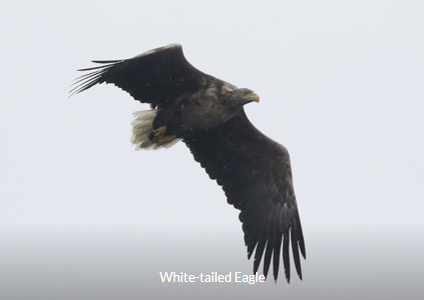
Unfortunately, on the last day of our South Korea winter birding tour the weather was once again poorer than desired. Heavy grey skies dominated in the early morning, developing into an annoying drizzle once more. Still, as yesterday, January Pension is ideally situated for this sort of thing so we took a little time to look out onto the bay from the sheltered deck there. On a nearby beach we spotted a White-tailed Eagle feeding on a dead fish while some Large-billed Crows watched on in hope of getting a few scraps. After finishing its meal it took off and gave some of us a great flypast view.
Out on the water it was interesting to see how things were different from the previous day with far smaller numbers of some species but bigger numbers of others. Today we could barely find a Rhinoceros Auklet while the day before they had been plentiful. The great numbers of Great Crested Grebes were much-reduced but something else incredible was happening as we scanned the bay. Huge numbers of Red-breasted Mergansers were arriving in squadrons of tens and twenties at a very rapid rate. The previous day we had seen a lot of Red-breasted Mergansers but this was far more impressive. Over the course of the next twenty minutes or so around 4500 Red-breasted Mergansers assembled in a massive, loose flock in the bay in front of our accommodation to create a very memorable spectacle.
Scattered among the merganser flock were a number of other interesting looking birds and we could see that the coastal road would take us closer. So, we packed up and left, planning to check out a variety of bays and headlands before heading back towards the west coast to conclude the tour.
At the first stop we were much closer to the merganser flock and from here we were able to get our best views of Red-necked Grebe and Harlequin duck, both at close range but the best sighting of the day was not a bird at all. At breakfast Sharon said that she had seen a seal in the bay and we all looked at her like she was going mad. Seals are extremely rare in these waters but as I was looking for rarer sea ducks I suddenly saw a seal surface and dive! Luckily the seal resurfaced and began to bob around so that we could all see it properly. It seems that this was a Northern Fur Seal and had probably drifted down from nearby North Korea where a population remains. Nial told us that these seals very rarely came into South Korean waters presumably because of the large amount of industry, fishing and naval activity in comparison to the quieter North Korean waters.
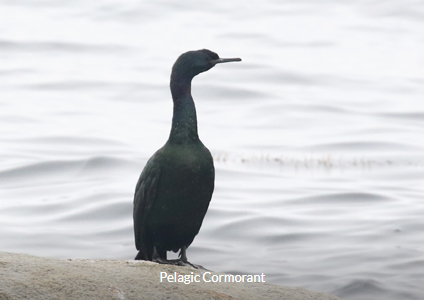
Further along we were able to watch groups of cormorants loafing around on some rocks, including one or two Temminck’s Cormorants that we could compare, at fairly close range, with the extremely similar Great Cormorants. Lots of gulls were also present but we could not find anything rarer than Mongolian Gull and Glaucous Gull, although a Blue Rockthrush showed for those who had not seen one the day before.
With the weather getting gradually poorer we had an early picnic lunch and a final look on a beach that is usually good for gull flocks. We found one first winter bird that neither I nor Nial could confidently ascribe to any particular species but this unusual situation was not enough to drag people out into the rain so we decided to head to our final birding spot of the tour, crossing the mountains in South Korea’s centre before the incoming cold weather turned drizzle into snow that might block the highway.
The journey took longer than expected but we arrived at Namhansanseong with some time to look for a couple of woodland birds that we were missing. Somehow we had not seen a White-backed Woodpecker on this tour, which is a bird we normally bump into at several places along the way. This type of thing often happens on a birding tour but we had built in enough time to make a special effort for this bird. The trail from the car park led us into a fairy tale woodland with golden leaves on the ground and on the trees. Flocks of small birds included several species we had not seen for some days including Marsh Tit, Coal Tit, a couple of Eurasian Nuthatches and a nice Eurasian Jay. Among one of the tit flocks we found a couple of Long-tailed Rosefinches and one of them had at least some sort of rosy flush to its plumage whereas all the previous individuals we had seen along the way were lacking any colour.
We had not got very far into the woods at all when the “pip” call of a small woodpecker alerted us to its presence. Some quiet searching allowed us to spot the source of the call which turned out to be our target: White-backed Woodpecker. It was not easy to get onto as it flitted around and hid behind branches but everyone managed to spot it in the end; it would have been strange to have missed this bird as it is not rare in South Korea in winter. Taking a longer walk around the woods we could not find anything else to add to our trip list so it became time to leave and head back to where we started the whole trip at our hotel near Incheon airport. Unfortunately we ran into a mass vehicular congestive situation but eventually we navigated the two vehicles back to our hotel from which we visited a nearby restaurant for a final dinner together where we could look back at our favourite birds, enjoy a beer or two and wish everyone a pleasant onward journey.
Incheon: Adjacent to our hotel there was a small harbour, a small park and a large area of rough reeds and scrub with an urban background, situated on the island upon which the international airport is built. Although there are no particular specialities this is a good spot for a variety of South Korea’s more abundant winter birds.
National Arboretum: A wooded valley and surrounding rolling hills covered in mixed deciduous and coniferous trees with a small, fast-flowing stream running through the middle of it. A series of pathways, trails and gardens make this a well-visited and pleasant site. Key species at National Arboretum included Solitary Snipe, Varied Tit and Japanese Pygmy Woodpecker.
White Horse Hill: A small wooded hill which is the site of a war memorial, overlooking rice fields and the DMZ. Areas of reeds and scrub along a stream provide habitat for a wider variety of species. This is a key site for White-naped Crane and Red-crowned Crane as they emerge from their roost site in the DMZ and fly into the fields to feed.
Cheorlwon Citizen Controlled Zone: An area of access-restricted farmland with copses, ditches and streams within the area. This area forms a buffer zone to the DMZ and people are only allowed in through daylight hours and visitors are not usually accommodated at all but we have contacts in South Korea who help us to gain access. This is a key site for Red-crowned Crane and White-naped Crane.
Gunnam Dam: A flood-control barrage across the Imjim River, a typical meandering, fast-flowing rocky waterway containing rocky islets and lined with woodland, scrub and emergent vegetation. This is a good site for a wide variety of winter birds but Hill Pigeon is the target species here.
Hamtam River: A wide, shallow river with surrounding parkland, fringing woodland and emergent scrub. Rocky islets, gravel bars and small man-made weirs provide areas for waterbirds to rest and forage. Japanese Wagtail and Long-billed Plover are specialities here.
Han River Paldang: The Han is the river that runs through South Korea’s capital city Seoul and at Paldang it is wide and shallow but still with an urban backdrop. Outcrops of rock, emergent islands and sand bars attract many birds and vegetation along the banks is good for wintering passerines. Steller’s Sea Eagle is the key species here but it is also a good location for Scaly-sided Merganser, Siberian Accentor, White-tailed Eagle and Mandarin Duck.
Oido Tidal Flats: Areas of mudflats exposed at low tide alongside flood defences and adjoined harbours. This can be a good area for a variety of wintering gulls.
Hwaseong Wetlands: A large area of reclaimed land that consists of rice fields, reed beds, scrub woodland, pools, reclamation lake and a reedy creek. Adjacent to this is a coastal area with large areas of mudflats exposed at low tide. This area is a good one for a wide variety of species including Upland Buzzard, Rough-legged Buzzard, Oriental Stork, Relict Gull, Saunders’s Gull, Pallas’s Reed Bunting, Chinese Grey Shrike, Black-faced Bunting and many others.
Guem River & Coast: A wide area of farmlands and coast close to the city of Gunsan. Stubble fields, tidal creeks, a wide river and its margins plus patches of gardens/parklands provide a wide range of habitats interspersed by villages and small towns. This area is key for Swan Goose, Baikal Teal, Taiga Bean Goose and Saunders’s Gull.
Osik Park Gunsan: A suburban park set on a small hill, covered in mixed woodland with grassy patches. A network of trails lead to a series of lookouts over the nearby town of Gunsan and the industrial coastal environment. Key species here include Warbling White-eye, Yellow-bellied Tit, Pale Thrush and Azure-winged Magpie.
Mangyeun Reservoir: A small reservoir surrounded by trees, orchards and farmland on the edge of a large village. This area is often used by large flocks of Rook usually with a few Daurian Jackdaws along for the ride. Waterfowl here often include Smew and Falcated Duck.
Suncheon Bay: An area famous in South Korea for its reed beds and for wintering Hooded Cranes which are given supplementary food on rice stubble fields which are criss-crossed by reedy ditches. This is also a good location for close up views of Cinereous Vulture and for finding rarer cranes among the flock of Hooded Cranes; Common and Sandhill Cranes often being present.
Merganser Creek: A rushing river running through and around a small town, flanked by a rocky gorge with wooded hillsides and scrubby undergrowth. As the river runs out of town the disturbance levels are greatly reduced making this a key site for Scaly-sided Merganser as well as Japanese Wagtail, Eurasian Eagle Owl and Mandarin Duck.
Junam Reservoir: Several shallow tree and reed-fringed lakes set among orchards and rice fields with woodland copses dotted around the landscape. Supplementary feeding often occurs here and this site is excellent for White-naped Crane, Swan Goose, Eurasian Spoonbill, Grey-headed Woodpecker, Light-vented Bulbul, White-cheeked Starling, Falcated Duck, Baikal Teal and a good place to find a surprise or two.
Nakdong Estuary/Forest Park: From various places around Busan the estuary can be viewed from riverside promenades. At low tide there are large areas of mudflats with sand bars, beaches and islands covered in reeds and riverine woodland. A rocky peninsula is forest-covered and has a series of trails running through it where woodland birds can be found. Key birds here include Steller’s Sea Eagle, Relict Gull, Blue Rockthrush, Pale Thrush and Yellow-bellied Tit.
Guryongpo Peninsula: A large peninsula of rocky coastline with sandy bays and fishing harbours along its length. Various points along the peninsula allow for sea watching and bays often hold interesting species. Stejneger’s Scoter, Ancient Murrelet, Glaucous Gull, Harlequin Duck, Black Scoter, Long-billed Murrelet and Rhinoceros Auklet are all frequently seen here.
Tabaeksan: High hills with wooded slopes and exposed tops where there are cabbage fields and a wind farm. The exposed areas are a key location for a wintering flock of Asian Rosy Finches.
Okge Services: A motorway service station that offers good, elevated views over the sea which is good for searching for rare alcids from the land.
Gangneung Lake: An ornamental lake within a city park that has fringing woodland and a small area of wooded wetlands which are maintained as a reserve for nature. This is an excellent site for getting extremely close views of wildfowl such as Northern Pintail, Goldeneye, Smew, Goosander as well as the best site we visit for Greater Scaup.
Daejin Coast: Coastline that includes fishing harbours, rocky outcrops, headlands, beaches and coastal vegetation. This is an excellent area for a variety of alcids, gulls, sea ducks, divers, cormorants and some wintering passerines.
Namhansanseong: A network of trails runs through forested hill ridges interspersed with historical monuments. When there is snow on the ground this is a very picturesque location and a good one for various woodpeckers, Naumann’s Thrush, Varied Tit and other woodland birds.
The sites at which each species were seen are coded as below;
- Incheon: I
- National Arboretum: NA
- Cheorlwon Citizen Controlled Zone: CCZ
- Gunnam Dam: GD
- Hamtan River: HR
- Oido Tidal Flats: OTF
- Hwaseong Wetlands: HW
- Guem River & Coast: GRC
- Osik Park Gunsan: OP
- Mangyeun Reservoir: MR
- Suncheon Bay: SB
- Merganser Creek: MC
- Junam Reservoir: JR
- Nakdong Estuary/Forest Park: NE
- Guryongpo Peninsula: GP
- Tabaeksan: T
- Okge Services: OS
- Gangneung Lake: GL
- Daejin Coast: DC
- Namhansanseong: NHS
During this South Korea Winter Birding Tour we recorded 159 species.
SPECIES
ANSERIFORMES: Anatidae
Swan Goose
Taiga Bean Goose
Tundra Bean Goose
Greater White-fronted Goose
Whooper Swan
Common Shelduck
Mandarin Duck
Baikal Teal
Northern Shoveler
Gadwall
Falcated Duck
Eurasian Wigeon
Eastern Spotbilled Duck
Mallard
Northern Pintail
Eurasian Teal
Common Pochard
Tufted Duck
Greater Scaup
Harlequin Duck
Stejneger’s Scoter
Black Scoter
Common Goldeneye
Smew
Common Merganser
Red-breasted Merganser
Scaly-sided Merganser
GALLIFORMES: Phasianidae
Common Pheasant
COLUMBIFORMES: Columbidae
Feral Pigeon
Hill Pigeon
Oriental Turtle Dove
GRUIFORMES: Rallidae
Eastern Water (Brown-cheeked) Rail
Eurasian Coot
GRUIFORMES: Gruidae
Sandhill Crane
White-naped Crane
Red-crowned Crane
Common Crane
Hooded Crane
PODICIPEDIFORMES: Podicipedidae
Little Grebe
Red-necked Grebe
Great Crested Grebe
Slavonian (Horned) Grebe
lack-necked (Eared) Grebe
CHARADRIIFORMES: Haematopodidae
Eurasian Oystercatcher
CHARADRIIFORMES: Charadriidae
Northern Lapwing
Grey Plover
Long-billed Plover
CHARADRIIFORMES: Scolopacidae
Eurasian Curlew
Sanderling
Dunlin
Solitary Snipe
Common Sandpiper
Green Sandpiper
Common Greenshank
CHARADRIIFORMES: Laridae
Black-headed Gull
Saunders’s Gull
Relict Gull
Black-tailed Gull
Common Gull
Glaucous Gull
Vega Gull
Mongolian Gull
Slaty-backed Gull
Heuglin’s (Taimyr) Gull
CHARADRIIFORMES: Alcidae
Long-billed Murrelet
Ancient Murrelet
Rhinoceros Auklet
GAVIIFORMES: Gaviidae
Red-throated Diver
Black-throated Diver
Pacific Diver
CICONIIFORMES: Ciconiidae
Oriental Stork
SULIFORMES: Phalacrocoracidae
Pelagic Cormorant
Great Cormorant
Temminck’s Cormorant
PELECANIFORMES: Threskiornithidae
Eurasian Spoonbill
PELECANIFORMES: Ardeidae
Grey Heron
Great Egret
Little Egret
ACCIPITRIFORMES: Accipitridae
Cinereous Vulture
Golden Eagle
Eurasian Sparrowhawk
Northern Goshawk
Northern Goshawk
Hen Harrier
Black Kite
White-tailed Eagle
Steller’s Sea Eagle
Rough-legged Buzzard
Upland Buzzard
Eastern Buzzard
STRIGIFORMES: Strigidae
Eurasian Eagle Owl
Short-eared Owl
BUCEROTIFORMES: Upupidae
Eurasian Hoopoe
PICIFORMES: Picidae
Japanese Pygmy Woodpecker
Great Spotted Woodpecker
White-backed Woodpecker
Grey-headed Woodpecker
FALCONIFORMES: Falconidae
Common Kestrel
Merlin
Peregrine Falcon
PASSERIFORMES: Laniidae
Bull-headed Shrike
Long-tailed Shrike
Chinese Grey Shrike
PASSERIFORMES: Corvidae
Eurasian Jay
Azure-winged Magpie
Oriental Magpie
Daurian Jackdaw
(Oriental) Rook
Carrion Crow
Large-billed Crow
Large-billed Crow
PASSERIFORMES: Paridae
Coal Tit
Yellow-bellied Tit
Varied Tit
Marsh Tit
Eastern Great Tit
PASSERIFORMES: Remizidae
Chinese Penduline Tit
PASSERIFORMES: Alaudidae
(Far Eastern) Skylark
PASSERIFORMES: Pycnonotidae
Light-vented Bulbul
Brown-eared Bulbul
PASSERIFORMES: Aegithalidae
Long-tailed Tit
PASSERIFORMES: Phylloscopidae
Dusky Warbler
PASSERIFORMES: Sylvidae
Vinous-breasted Parrotbill
PASSERIFORMES: Zosteropidae
Warbling White-eye
PASSERIFORMES: Regulidae
Goldcrest
PASSERIFORMES: Troglodytidae
Eurasian Wren
PASSERIFORMES: Sittidae
Eurasian Nuthatch
PASSERIFORMES: Sturnidae
Red-billed Starling
White-cheeked Starling
PASSERIFORMES: Turdidae
Pale Thrush
Naumann’s Thrush
Dusky Thrush
PASSERIFORMES: Muscicapidae
Red-flanked Bluetail
Daurian Redstart
Blue Rockthrush
PASSERIFORMES: Cinclidae
Brown Dipper
PASSERIFORMES: Passeridae
Eurasian Tree Sparrow
Russet Sparrow
PASSERIFORMES: Prunellidae
Siberian Accentor
PASSERIFORMES: Motacillidae
White Wagtail
White Wagtail
Japanese Wagtail
Olive-backed Pipit
Buff-bellied Pipit
PASSERIFORMES: Fringillidae
Brambling
Hawfinch
Chinese Grosbeak
Asian Rosy Finch
Long-tailed Rosefinch
Common Rosefinch
Grey-capped Greenfinch
Eurasian Siskin
PASSERIFORMES: Emberizidae
Meadow Bunting
Chestnut-eared Bunting
Little Bunting
Rustic Bunting
Yellow-throated Bunting
Black-faced Bunting
Pallas’s Reed Bunting
Common Reed Bunting
SCIENTIFIC NAME
Anatidae
Anser cygnoides
Anser fabalis middendorffii
Anser serrirostris serrirostris
Anser albifrons frontalis
Cygnus cygnus
Tadorna tadorna
Aix galericulata
Sibirionetta formosa
Spatula clypeata
Mareca strepera strepera
Mareca falcata
Mareca penelope
Anas zonorhyncha
Anas platyrhynchos
Anas acuta
Anas crecca
Aythya ferina
Aythya fuligula
Aythya marila nearctica
Histrionicus histrionicus
Melanitta stejnegri
Melanitta americana
Bucephala clangula clangula
Mergellus albellus
Mergus merganser orientalis
Mergus serrator
Mergus squamatus
GALLIFORMES: Phasianidae
Phasianus colchicus karpowi
COLUMBIFORMES: Columbidae
Columba livia
Columba rupestris
Streptopelia orientalis orientalis
GRUIFORMES: Rallidae
Rallus indicus
Fulica atra atra
GRUIFORMES: Gruidae
Antigone canadensis
Antigone vipio
Antigone japonensis
Grus grus
Grus monarcha
PODICIPEDIFORMES: Podicipedidae
Tachybaptus ruficollis poggei
Podiceps grisegana halballii
Podiceps cristatus cristatus
Podiceps auritus auritus
Podiceps nigricollis nigricollis
CHARADRIIFORMES: Haematopodidae
Haemantopus ostralegus osculans
CHARADRIIFORMES: Charadriidae
Vanellus vanellus
Pluvialis squatarola squatarola
Charadrius placidus
CHARADRIIFORMES: Scolopacidae
Numenius arquata orientalis
Calidris alba rupina
Calidris alpina
Gallinago solitaria japonica
Actitis hypoleucos
Tringa ochropus
Tringa nebularia
CHARADRIIFORMES: Laridae
Chroicocephalus ridibundus
Chroicocephalus saundersi
Ichthyaetus relictus
Larus crassirostris
Larus canus
Larus hyperboreus pallidissimus
Larus vegae
Larus mongolicus
Larus schistisagus
Larus heuglini taimyrensis
CHARADRIIFORMES: Alcidae
Brachyramphus perdix
Synthliboramphus antiquus
Cerorhinca monocerata
GAVIIFORMES: Gaviidae
Gavia stellata
Gavia arctica viridgularis
Gavia pacifica
CICONIIFORMES: Ciconiidae
Ciconia boyciana
SULIFORMES: Phalacrocoracidae
Phalacrocorax pelagicus
Phalacrocorax carbo sinensis
Phalacrocorax capillatus
PELECANIFORMES: Threskiornithidae
Platalea leucorodia leucordia
PELECANIFORMES: Ardeidae
Ardea cinerea jouyi
Ardea alba
Egretta garzetta garzetta
ACCIPITRIFORMES: Accipitridae
Aegypius monachus
Aquila chrysaetos
Accipiter nisus
Accipiter gentilis schvedowi
Accipiter gentilis fujiyamae
Circus cyaneus
Milvus migrans lineatus
Haliaeetus albicilla albicilla
Haliaeetus pelagicus
Buteo lagopus
Buteo hemilasius
Buteo japonicus japonicus
STRIGIFORMES: Strigidae
Bubo bubo kiautschensis
Asio flammeus
BUCEROTIFORMES: Upupidae
Upupa epops epops
PICIFORMES: Picidae
Yungipicus kizuki nippon
Dendrocopos major japonicus
Dendrocopos leucotos leucotis
Picus canus jessoensis
FALCONIFORMES: Falconidae
Falco tinnunculus interstinctus
Falco columbarius insignis
Falco peregrinus japonensis
PASSERIFORMES: Laniidae
Lanius bucephalus bucephalus
Lanius schach schach
Lanius sphenocercus
PASSERIFORMES: Corvidae
Garrulus glandarius brandtii
Cyanopica cyanus cyanus
Pica sericea anderssoni
Coloeus dauuricus
Corvus frugilegus pastinator
Corvus corone orientalis
Corvus macrorhynchos mandshurius
Corvus macrorhynchos japonensis
PASSERIFORMES: Paridae
Periparus ater ater
Pardaliparus venustulus
Sittiparus varius varius
Poecile palustris hellmayri
Parus minor
PASSERIFORMES: Remizidae
Remiz consobrinus
PASSERIFORMES: Alaudidae
Alauda arvensis japonica
PASSERIFORMES: Pycnonotidae
Pycnonotus sinensis sinensis
Pycnonotus amaurotis amaurotis
PASSERIFORMES: Aegithalidae
Aegithalos caudatus magnus
PASSERIFORMES: Phylloscopidae
Phylloscopus fuscatus
PASSERIFORMES: Sylvidae
Sinosuthora webbiana fulvicauda
PASSERIFORMES: Zosteropidae
Zosterops japonicus japonicus
PASSERIFORMES: Regulidae
Regulus regulus japonensis
PASSERIFORMES: Troglodytidae
Troglodytes troglodytes dauricus
PASSERIFORMES: Sittidae
Sitta europaea amurensis
PASSERIFORMES: Sturnidae
Spodiopsar sericeus
Spodiopsar cineraceus
PASSERIFORMES: Turdidae
Turdus pallidus
Turdus naumanni
Turdus aunomus
PASSERIFORMES: Muscicapidae
Tarsiger cyanurus
Phoenicurus auroreus
Monticola solitarius philippensis
PASSERIFORMES: Cinclidae
Cinclus pallasii pallasii
PASSERIFORMES: Passeridae
Passer montanus saturatus
Passer cinnamomeus rutilans
PASSERIFORMES: Prunellidae
Prunella montanella montanella
PASSERIFORMES: Motacillidae
Motacilla alba leucopsis
Motacilla alba lugens
Motacilla grandis
Anthus hodgsoni hodgsoni
Anthus rubescens japonicus
PASSERIFORMES: Fringillidae
Fringilla montifringilla
Coccothraustes coccothraustes schulpini
Eophona migratoria migratoria
Leucosticte arctoa brunneonucha
Carpodacus sibiricus ussuriensis
Carpodacus erythrinus
Chloris sinica ussuriensis
Spinus spinus
PASSERIFORMES: Emberizidae
Emberiza cioides castaneiceps
Emberiza fucata fucata
Emberiza pusilla
Emberiza rustica
Emberiza elegans elegans
Emberiza spodocephala
Emberiza pallasi pallasi
Emberiza schoeniculus pyrrhulina
SITES SEEN
Anatidae
GRC, JR
Most wetland sites
Most wetland sites
Most wetland sites
HRP, HSW, JR
HSW, GRC
MC
GRC
JR
GRC, MR
GRC, MR, JR
Most wetland sites
Most wetland sites
Most wetland sites
OTF, SB, JR, G
Most wetland sites
JR, HW, GL, HRP
GD, JR, HW
GL
GP, DC
GP, DC
DC
Most wetland sites
Most wetland sites
Most wetland sites
I, GD, GRC, DC, GP
HRP, MC
GALLIFORMES: Phasianidae
I, NA, CCZ, GRC
COLUMBIFORMES: Columbidae
All sites
GD
All sites
GRUIFORMES: Rallidae
JR
GD, MR, JR, G, DC
GRUIFORMES: Gruidae
JR
WHH, CCZ, JR
WHH, CCZ, GD
SB, JR
WHH, SB, JR
PODICIPEDIFORMES: Podicipedidae
Most wetland sites
GP, DC
Most wetland sites
GP, DC, GL
NE, GP, DC
CHARADRIIFORMES: Haematopodidae
OTF, HW, NE
CHARADRIIFORMES: Charadriidae
GRC, SB, GN
HW, NE
HR, GRC
CHARADRIIFORMES: Scolopacidae
OTF, GRC
GP
GRC, HW
NA
MC
HR
GRC
CHARADRIIFORMES: Laridae
GRC, SB, JR, NE, GP
HW, GRC
HW
All coastal sites
Most coastal sites
GP, DC
Most coastal sites
Most wetland sites
GP, DC
OTF, NE, GP, DC
CHARADRIIFORMES: Alcidae
OS
GP, OS
OS, DC
GAVIIFORMES: Gaviidae
GP, DC
GP, DC
GP, DC
CICONIIFORMES: Ciconiidae
HW
SULIFORMES: Phalacrocoracidae
GP, DC
Most wetland sites
GP
PELECANIFORMES: Threskiornithidae
HW, JR, NE
PELECANIFORMES: Ardeidae
All wetland sites
All wetland sites
HW, GP
ACCIPITRIFORMES: Accipitridae
CZZ, GD, SB, JR, TS
GD
Most sites
Many sites
GRC
HW, GRC, SB, JR
NE
Many locations
HRP
HW
HW, SB
Most sites
STRIGIFORMES: Strigidae
MC
GRC
BUCEROTIFORMES: Upupidae
HW, SB, JR, GP
PICIFORMES: Picidae
I, NA, WHH, OP, JR, NHS
I, NA, WHH, CCZ, GD, OP, JR, TS, NHS
NHS
NA, JR
FALCONIFORMES: Falconidae
I, NA, CCZ, GRC, HW, JR
HW
CCZ, SB
PASSERIFORMES: Laniidae
Most sites
JR
HW
PASSERIFORMES: Corvidae
OP, NHS
OP
All sites
MR
MR, TS
I, HRP
Most sites
NE, GP
PASSERIFORMES: Paridae
NA, OP, JR, NHS
OP
NA, OP, JR, NHS
I, NA, GD, OP, DC, NHS
All sites
PASSERIFORMES: Remizidae
HW
PASSERIFORMES: Alaudidae
HW, SB, JR
PASSERIFORMES: Pycnonotidae
JR, NE, GP, DC
All sites
PASSERIFORMES: Aegithalidae
NA, OP, JR, TS
PASSERIFORMES: Phylloscopidae
SB
PASSERIFORMES: Sylvidae
Most sites
PASSERIFORMES: Zosteropidae
OP, JR, NE
PASSERIFORMES: Regulidae
NA
PASSERIFORMES: Troglodytidae
JR
PASSERIFORMES: Sittidae
NA, WHH
PASSERIFORMES: Sturnidae
OP
OP, JR
PASSERIFORMES: Turdidae
OP, JR
I, NA, WHH, OP, TS, DC, NHS
MR
PASSERIFORMES: Muscicapidae
OP
All sites
DC
PASSERIFORMES: Cinclidae
TS
PASSERIFORMES: Passeridae
All sites
GP
PASSERIFORMES: Prunellidae
GD
PASSERIFORMES: Motacillidae
JR, DC
All sites
HR, HRP, SB
HRP, OP, JR, NE
HR, SB, JR, NE
PASSERIFORMES: Fringillidae
I, NA, WHH, CCZ, GD, JR, DC
I, NA, WHH, CCZ
OP
TS
CZZ, GD, DC
OP
Most sites
NA, OP
PASSERIFORMES: Emberizidae
CZZ, TS
JR
JR
Most sites
Most sites
HW
I, HW, SB
HW
South Korea winter birding tour photo gallery
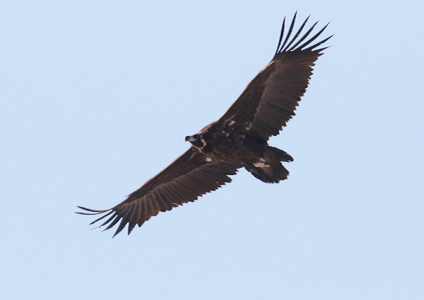
Cinereous Vulture 
Bull-headed Shrike 
Mongolian Gull 
Naumann’s Thrush

